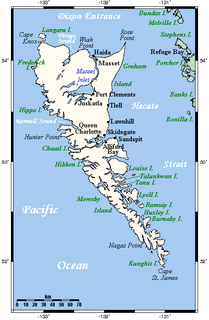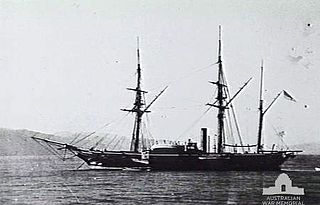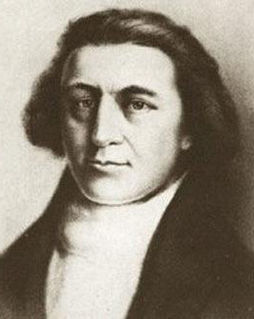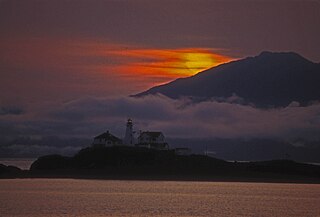Virago Sound is a sound on the north coast of the Graham Island in the Queen Charlotte Islands, British Columbia, Canada, at the entrance to Naden Harbour.

In geography, a sound is a large sea or ocean inlet, deeper than a bight and wider than a fjord; or a narrow sea or ocean channel between two bodies of land.

Graham Island is the largest island in the Haida Gwaii archipelago, lying off the coast of British Columbia, Canada. It is separated only by a narrow channel from the other principal island of the group, Moresby Island. It has a population of 4,475, an area of 6,361 km2 (2,456 sq mi), and is the 101st largest island in the world and Canada's 22nd largest island.

British Columbia is the westernmost province of Canada, located between the Pacific Ocean and the Rocky Mountains. With an estimated population of 5.016 million as of 2018, it is Canada's third-most populous province.
The sound is named for HMS Virago, a Royal Navy sloop-of-war surveying these waters in 1853, under the command of Master George H. Inskip. The Haida name for Virago Sound was "tin-eye", meaning "big"

HMS Virago was a 1669-ton, Royal Navy 6 gun 1st class paddle sloop launched on 25 July 1842 from Chatham Dockyard.

The Royal Navy (RN) is the United Kingdom's naval warfare force. Although warships were used by the English kings from the early medieval period, the first major maritime engagements were fought in the Hundred Years War against the Kingdom of France. The modern Royal Navy traces its origins to the early 16th century; the oldest of the UK's armed services, it is known as the Senior Service.

In the 18th century and most of the 19th, a sloop-of-war in the Royal Navy was a warship with a single gun deck that carried up to eighteen guns. The rating system covered all vessels with 20 guns and above; thus, the term sloop-of-war encompassed all the unrated combat vessels, including the very small gun-brigs and cutters. In technical terms, even the more specialised bomb vessels and fireships were classed as sloops-of-war, and in practice these were employed in the sloop role when not carrying out their specialized functions.
In 1792 Captain Ingraham of the brig Hope had named these waters Port Crafts after his first mate, John Croft or Cruft:
Joseph Ingraham (1762–1800) was an American sailor and maritime fur trader who discovered several islands of the Marquesas Islands while on his way to trade along the west coast of North America. He was also a prisoner in the American Revolutionary War and an officer in the United States Navy.

A brigantine is a two-masted sailing vessel with a fully square rigged foremast and at least two sails on the main mast: a square topsail and a gaff sail mainsail. The main mast is the second and taller of the two masts.
Hope was an American brig or sloop involved in the Maritime Fur Trade along the northwest coast of North America and discovery in the Pacific Ocean. Earlier Hope had made two voyages in the slave trade.
"In 1791, Captain Joseph Ingraham on the small brig Hope out of Boston, Massachusetts, spent time along the British Columbia coast trading for furs at Native American villages. His first officer was John Cruft. In Ingraham's logbook (original in the Smithsonian Library, Washington, DC) he mentions that he named an anchorage "Cruft's Cove after my chief officer...." (volume ii, p.80). This occurred a year (or possibly two) prior to the arrival of Captain Vancouver to the area."
- (Information provided to the BCGNIS January 2008 by John Bakke, Portland, Oregon, descendant of John Cruft)









